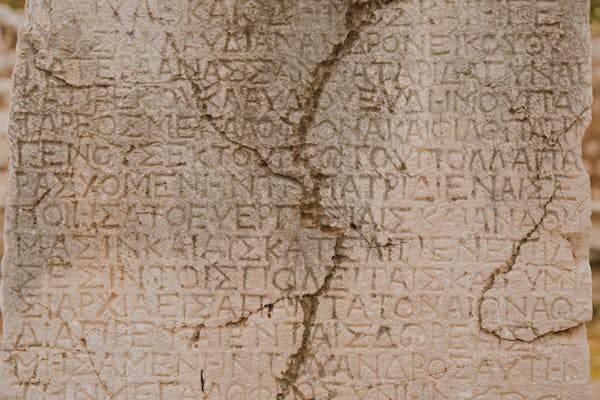Pop quiz! How many letters in the English alphabet?
Spoiler – the answer is 26.
The English alphabet is a fundamental aspect of communication for millions of people around the world. It serves as the basis for reading, writing, and speaking the English language. But have you ever stopped to wonder how many letters in the English alphabet and the origins of each, individual letter?
In this article, we will explore the origins of the English alphabet, its evolution over time, and interesting facts that make this collection of letters truly fascinating.
Table of contents
The Origin of the English Alphabet
Before we get into how many letters in the English alphabet, let’s look at the origin of said letters.
The roots of the English alphabet can be traced back to the fascinating world of ancient Greece. It was the Greek alphabet that laid the foundation for the alphabets of many Western languages, including English, as we know it today.
The Greek alphabet, believed to have emerged around the 8th century BCE, has a captivating history deeply intertwined with the evolution of linguistic communication.
The Greek alphabet was not conjured out of thin air; it evolved from the Phoenician writing system, which was widely used in the ancient Mediterranean world. The Phoenician script consisted primarily of consonants, which posed limitations for representing the rich array of sounds found in languages.
However, the ingenious Greeks took this system and transformed it into something more comprehensive and adaptable. The Greek alphabet initially comprised 24 letters, each representing specific consonant and vowel sounds.
You might also like: 4 Strategies That Will Help You Express Yourself in English

Names of the Letters
Now that we know how many letters are in the English alphabet, let’s delve deeper into each individual letter.
What makes the story even more intriguing is the names assigned to these letters. In Greek, the first two letters of their alphabet were named “alpha” and “beta.” These names, which later evolved into the familiar “A” and “B,” were derived from the Phoenician words for ox (“aleph”) and house (“beth”).
These names held significant meaning in the Phoenician culture, representing essential elements of their society.
As the Greek alphabet continued to develop and spread, it became apparent that the original 24 letters were not sufficient to accurately represent the intricate sounds of various languages.
This realization led to the addition of more letters, expanding the alphabet’s capacity for linguistic expression. It was during this evolution that the Greek alphabet laid the groundwork for the alphabets of many languages, English included.
It was the Greek alphabet that laid the foundation for the alphabets of many Western languages, including English, as we know it today
The Transmutation into Modern English
Fast forward through time, and we arrive at the English alphabet that graces our books, screens, and everyday lives.
The transition from the Greek alphabet to the English one was a journey marked by cultural exchanges, historical developments, and linguistic adaptations.
The letter names “alpha” and “beta,” descendants of ancient Greece, found their way into the Roman alphabet through Latin influence. The Romans, in their conquests and interactions with various cultures, adopted and adapted the Greek alphabet to suit their own needs.
This led to the introduction of the Latin alphabet, which eventually became the foundation for many European languages, including English. In the evolution from Latin to Old English, the letter names underwent modifications to align with the phonetic characteristics of the language. These modifications included changes in pronunciation, spelling, and the development of distinct noun phrases to describe certain phonetic features, marking an important stage in the transition from Latin to Old English writing systems.
Over time, these names transformed into the familiar A, B, C, and so on. The alphabet itself evolved, too, as the Anglo-Saxons used it to record their own language and culture. However, even as the names and forms of the letters shifted, the legacy of the Greek alphabet remained imprinted on the linguistic DNA of English.
The Original 23 Letter Old English Alphabet
So, once again… how many letters in the English alphabet?
Originally, there were 23!
The English alphabet as we know it today has undergone several transformations throughout history.
In the early days of Old English, the alphabet consisted of 23 letters, omitting the letters J, U, and W. These three letters were later added to the alphabet, expanding it to the 26 letters we recognize today. The addition of J and U came about during the Renaissance period, while W was introduced in the 12th century.
The inclusion of these letters was driven by the need to represent sounds that were not adequately covered by the existing alphabet.
You might also like: Overcome Your Fear and Start Speaking in English

English Alphabet vs Other Alphabets
The 26 letters in the English Alphabet can be put it in the middle range when compared to other alphabets around the world.
Some languages have more extensive alphabets, while others have more concise ones. At the upper end of the spectrum, the Khmer alphabet used for the Khmer language of Cambodia boasts an impressive 74 letters. This alphabet is known for its ornate script and intricate characters.
Similarly, the Georgian alphabet, used for the Georgian language, consists of 33 letters. The inclusion of unique characters and the representation of distinct phonetic sounds contribute to the larger number of letters in these alphabets.
On the other hand, the Rotokas alphabet, used for the Rotokas language spoken in Papua New Guinea, holds the title for the shortest alphabet with only 11 letters. This minimalistic alphabet reflects the simplicity of the language’s phonetic structure.
Interesting Facts About the Alphabet
The Pangram Challenge:
A pangram is a sentence that contains every letter of the alphabet at least once. The most well-known pangram in English is “The quick brown fox jumps over a lazy dog.” Pangrams are often used for typing practice and testing fonts.
Longest Word Using Each Letter Once:
“Subdermatoglyphic” is often considered one of the longest words in the English language that uses each letter exactly once. While it might not be a commonly used word, it showcases the intricacies of the English alphabet.
Evolution of Letter Shapes:
The shapes of letters in the English alphabet have evolved over time. For instance, the letter “A” was once written as a symbol resembling an ox head, representing the sound “ah.”
FAQ –
What is the 27th letter in the alphabet?
- Ampersand
What English letters are no longer used?
- In the orthography of Modern English, the letters thorn (þ), eth (ð), wynn (ƿ), yogh (ȝ), ash (æ), and ethel (œ) were taken out as they were deemed obsolete.
What is the most unused letter in the alphabet?
- As you can probably guess, the letter Z is the least commonly used letter in the English alphabet. The letter Q is a close second as the least commonly used letter.
Final Thoughts
The English alphabet is a testament to the evolution of language and communication.
From its Greek origins and Old English roots to its current form with 26 letters, the alphabet has adapted to meet the changing needs of speakers and writers.
While not the longest or shortest alphabet in the world, the English alphabet remains a vital tool for expression and understanding. Its quirks and idiosyncrasies only add to its allure, making it a fascinating subject of study and exploration.
So, the next time you recite the alphabet or write a sentence, take a moment to appreciate the rich history and complexity of the letters that shape our language.
Meet Amphy
The largest marketplace for live
classes, connecting and enriching
humanity through knowledge.
Related Articles